August 2005 archives
August 1, 2005
Making an adjustable heavy-duty squat box
The renovation of Toffe’s Gym continues. With my old squat box having emigrated to Helsinki, it was time to build a new one. Following the “good enough for Mikesell” line of thought, it had to be a much sturdier thing adjustable to at least 10″ (my low box), 13″ (below parallel) and 17″ (high box). The solution was to build a 10″ base box with separate 3″ and 4″ add-on layers - on the Westside tapes, most boxes are also piles of something. The add-ons will also be handy for things like elevated deadlifts. Since I opted for a concrete base for the power rack, I was left with a bunch of treated 2x6″ boards that I now put to good use. Made the box a respectable 24″x26″ (61x66cm), significantly wider than the 18x18″ adjustable squat box from EliteFTS . With nearly 8 meters/26 feet of 2x6″ going into the base box, you can image how heavy this beast is… Once everything was hammered together, I grabbed the magnifying glass and burned the strategic numbers into the wood. Done.
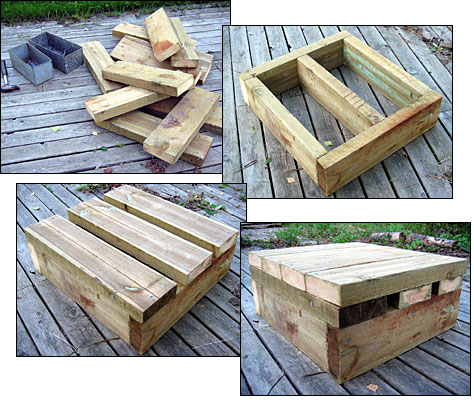
Pile to finish - the building of the 10″ base box.
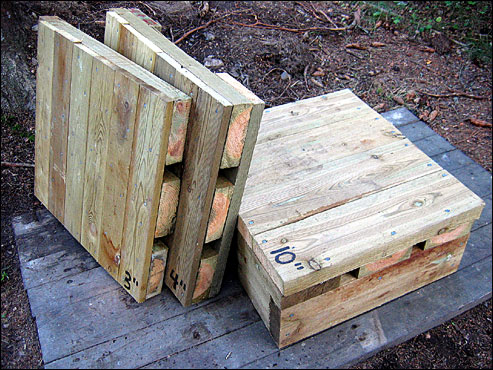
The complete box with 3″ and 4″ add-ons.
August 8, 2005
Week 32: Bench shrugs and other fun things
Monday, 1 August 2005: ~SQ/DL
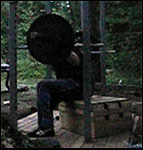 Ever the optimist, I had to try out my new squat box to the tune of Finnish metal band Teräsbetoni (eng. reinforced concrete). I find the heroic medieval battle lyrics to be a bit too much, but those who want something exotic might want to give the Metallitotuus album a whirl. Worked up to 90 kg/199 lbs and made the sensible decision to stop there. The back didn’t twist up too badly, but I could definitively feel it. Wrapped up with two non-stop ab circuits on the stability ball.
Ever the optimist, I had to try out my new squat box to the tune of Finnish metal band Teräsbetoni (eng. reinforced concrete). I find the heroic medieval battle lyrics to be a bit too much, but those who want something exotic might want to give the Metallitotuus album a whirl. Worked up to 90 kg/199 lbs and made the sensible decision to stop there. The back didn’t twist up too badly, but I could definitively feel it. Wrapped up with two non-stop ab circuits on the stability ball.
Box squat, 13″:
5 @ 50 kg/111 lbs
5 @ 60 kg/133 lbs
5 @ 70 kg/155 lbs
1 @ 80 kg/177 lbs
1 @ 90 kg/199 lbs
Swiss ball ab circuit (non-stop): 2 non-stop circuits of 20 reps each
crunch
left side bend
hyperextension
right side bend
Tuesday, 2 August 2005: Bench
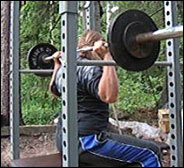 This was a great workout! For one thing, I was able to add another 2.5 kg/6 lbs on the behind-the-neck press for a clean 5x5 @ 55 kg/122 lbs. For another, it just plain felt great to be outdoors doing good stuff like reverse-grip benches, bench shrugs and lying rows. Since I finally caught the bench shrugs on tape (8.1MB), it is time to say a few words about this beast.
This was a great workout! For one thing, I was able to add another 2.5 kg/6 lbs on the behind-the-neck press for a clean 5x5 @ 55 kg/122 lbs. For another, it just plain felt great to be outdoors doing good stuff like reverse-grip benches, bench shrugs and lying rows. Since I finally caught the bench shrugs on tape (8.1MB), it is time to say a few words about this beast.
Bench shrugs involves assuming a normal benching position and then pushing the bar up by hunching the shoulders off the bench without bending the arms. This hits the pectoralis minor heavily. The first time I saw this exercise was on Blakley’s XTM bench tape where he called them “pec minor pops”. Blakley prescribes these for stabilizing the shoulder area to protect against the wear and tear of heavy lifting (as in shoulder pain). Recently, I was reminded of these when I read Kelso’s shrug book where they go under the logical name of “bench shrugs”. I am not including these based on any weakness analysis, but, like Blakley, Kelso assures his captivated reader that “this movement will [..] greatly strengthen the shoulder girdle for whatever purpose” (pp. 36). A strong shoulder girdle simply cannot be wrong.
Incidentally, 1960s bench legend Jim Williams, who sported an official 700 lbs/317 kg raw bench, was also a big fan of these “lying shrugs”. Unlike Blakley and Kelso, he always did these with dumbells for maximum range of motion. The chapter on Williams in The Bench Press by Biasiotto and Arndt does not specifically mention lying shrugs, but they are found in the attached program for 10 sets of 10 (pp. 60-61). I have no idea of the source, but I also found Williams’s own description of the movement cited on the Old School Strength Training board:
Now I will explain “my secret”-the lying shoulder shrug. After you are through with a light chest workout on the bench, find a pair of dumbbells that you can only get about 3 reps out of until failure, and as you increase in your shoulder strength, you will increase the dumbbell, even if you can’t press them once!
While lying on the bench, have 2 friends hand you the dumbbells. After doing the three reps, pause for about three exhales. Slowly let the shoulders slide down almost like relaxing. As they reach the desired angle, stop them and immediately raise them (by lifting them) as high as you can. This should be done with the dumbbells partially being held and partially lying on the delts. This should be done in sets of 10 reps, if you can, or one should work up to it. Remember, you are not pushing the weight with your triceps, because the problem is not in the completion, but the start. You may say, “Jimmy, why not use the bar?” A bar is what pins you to begin with, and secondly…it wouldn’t give you the necessary movement one needs in trying to shrug up and in. Some of the sensation that you may be able to relate to is like doing a complete dip, in which you let the body slide all the way down. Before your arms can come into play, you must first lift the body, than push with the arms. The same sensation happens at the end of he dip on a complete extension, when you cause the shoulders to raise the body.
Dips are not an easy answer because the shoulder movement in that excersise moves in a downward direction. But doing “my Shoulder Shrugs”, the shoulders move in an upward movement. How many times can I use this workout? It should be done during a training period for at least three times a week in a five-day-a-week training cycle.
Should I lose imediately on my bench? You should stabilize until shoulders gradually begin to heal. Upon the end of your training cycle, the lying shrugs should be stopped in favor of complete healing and growth. Remember, the heavier you can handle, the better. Dumbbells you can press for 6 reps to 10 reps are no good.
Add these shrugs to the rest of my workouts and you are sure to come up with the best bench press at any meet. Remember, this does not mean that you stop doing other shoulder work, but that my Shoulder Shrugs should be added.
As we Northern Europeans like to say, a dear child has many names. And that’s all I’m going to say about that.
worked up to 5x5 @ 55 kg/122 lbs
Reverse-grip bench, feet in air:
8 @ 50 kg/111 lbs
8 @ 60 kg/133 lbs
5 @ 70 kg/155 lbs
5 @ 80 kg/177 lbs
Bench shrug:
10 @ 60 kg/133 lbs
10 @ 70 kg/155 lbs
10 @ 80 kg/177 lbs
10,7 @ 90 kg/199 lbs
Lying rows, reverse-grip:
8 @ 60 kg/133 lbs
3x8 @ 70 kg/155 lbs
Sunday, 7 August 2005: Bench
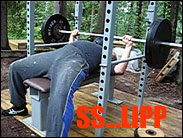 After the easy 105 kg/232 lbs decline, I figured the same on the vanilla bench would be child’s play. It wasn’t, but a nasty slip of the left foot on the wooden floor wetted by rain made sure I would never know. One word: rubber mat. Decided to get my feet out of harm’s way by raising them towards the sky. Got a very easy 90 kg/199 lbs on the reverse-grip bench with feet in the air, but for some ungroovy reason 95 kg/210 lbs was a total flop. Lying L-flyes.
After the easy 105 kg/232 lbs decline, I figured the same on the vanilla bench would be child’s play. It wasn’t, but a nasty slip of the left foot on the wooden floor wetted by rain made sure I would never know. One word: rubber mat. Decided to get my feet out of harm’s way by raising them towards the sky. Got a very easy 90 kg/199 lbs on the reverse-grip bench with feet in the air, but for some ungroovy reason 95 kg/210 lbs was a total flop. Lying L-flyes.
If you didn’t catch it already, here’s this week’s video summary (8.1MB). A tall order at 4:28, this will take some patience in today’s internet/remote control world. Evil.
6 @ 42.5 kg/94 lbs
5 @ 52.5 kg/116 lbs
5 @ 65 kg/144 lbs
2 @ 75 kg/166 lbs
1 @ 85 kg/188 lbs
1 @ 95 kg/210 lbs
0 @ 105 kg/232 lbs
Reverse-grip bench, feet in air:
5 @ 60 kg/133 lbs
1 @ 70 kg/155 lbs
1 @ 80 kg/177 lbs
1 @ 90 kg/199 lbs
0 @ 95 kg/210 lbs
Lying L-flyes:
6 @ 10 kg/22 lbs
August 13, 2005
Week 33: Return of the teacher
All good things must come to an end, but why did I have to trade in the peaceful family existence at the summer cottage and Toffe’s gym for work this soon…? Why oh why?
Anyway. My dough will continue to come mainly from being a full-time teacher in a Swedish-speaking elementary school here in Helsinki (sixth grade). If last year is anything to go by, this will be a laborious yet rewarding year. With family and sleep high on the agenda, I will keep my usual freelancing activities (translating and teaching courses on Asia) to a minimum. On the training front, it is time to head indoors. For the time being, the natural place to go is the school gym. Only got one workout in this week though with a good headstart on 57.5 kg/127 lbs behind-the-neck presses. Also noted that my right wrist appears to be pretty sore after last week’s reverse grip benches. Got to lay off those for a while.
Behind-the-neck press:
worked up to 5,5,5,4,3 @ 57.5 kg/127 lbs
Close-grip bench, feet in air:
8 @ 40 kg/88 lbs
5 @ 50 kg/111 lbs
5 @ 60 kg/133 lbs
5 @ 70 kg/155 lbs
4 @ 80 kg/177 lbs
Bench shrug:
10 @ 60 kg/133 lbs
10 @ 70 kg/155 lbs
10 @ 80 kg/177 lbs
10 @ 90 kg/199 lbs
10 @ 95 kg/210 lbs
Close-grip pulldown: 3x12 @ 80 kg/177 lbs
Rope pulls: 2x12 @ 45 kg/99 lbs
August 18, 2005
Week 34: First free squats max and a floor press PR
Monday, 15 August 2005: SQ/DL
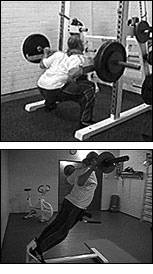 Over the two plus years I’ve been doing this powerlifting thing, I have never really gotten beyond the box squat. Last year, some four months after the infamous good morning injury, I had big plans for working with squat king Brent Mikesell on my form and embarked on free standing squats. Two workouts later, my lower back wasn’t worth the T-shirt it was draped in as I began a long struggle with recurrent low back problems. They are still with me it seems, but since I felt pretty ok I started to slowly work my way up. Things felt good, and I ended up maxing out at 100 kg/221 lbs and failing at 110 kg/243 lbs. Baby weights for sure, but this was a minor victory of sorts for me.
Over the two plus years I’ve been doing this powerlifting thing, I have never really gotten beyond the box squat. Last year, some four months after the infamous good morning injury, I had big plans for working with squat king Brent Mikesell on my form and embarked on free standing squats. Two workouts later, my lower back wasn’t worth the T-shirt it was draped in as I began a long struggle with recurrent low back problems. They are still with me it seems, but since I felt pretty ok I started to slowly work my way up. Things felt good, and I ended up maxing out at 100 kg/221 lbs and failing at 110 kg/243 lbs. Baby weights for sure, but this was a minor victory of sorts for me.
Comments on my squat form are warmly welcome (weekly video summary, 6.5M). One thing I notice from the video is that my lower back rounds at the very bottom of the squat. I’ve also started to wonder whether I am sitting back a little too much for a raw squatter. My knees hardly move forward at all, which is what an equipped squat should look like, but perhaps the price I am paying for not having any artificial support in the hole is that the upper body is forced forward a bit more than it should (admittedly, my core strength is also lagging). I remember reading somewhere that raw lifters can generally get away with a bit of forward knee movement. I need to experiment, it could well be that I could squat more weight if I came down straighter.
Another minor victory was getting hold on a copy of the EliteFTS Squat/Deadlift Exercise Index DVD from Voimaharjoittelu.net for a bargain 20 euros. A minor chip, hardly something that would bother me, was missing from the box which accounts for the whopping 39 euro saving compared to the retail price. That’s a great deal if any! After watching the DVD rave over the how effective a back piece the 45 degree hyper is and how you can easily get in and out by yourself with added weight, I looked at the school hyper with new eyes. Of course it doesn’t have the wide base and band pegs like the EliteFTS model, but it did turn out to be fairly easy to get in with a [light] barbell. The best thing ever, also gleaned from the DVD, were side bends with a dumbell on the same piece. Obliques burning in hell!
5 @ 40 kg/88 lbs
5 @ 50 kg/111 lbs
6 @ 60 kg/133 lbs
5 @ 70 kg/155 lbs
1 @ 80 kg/177 lbs
1 @ 90 kg/199 lbs
1 @ 100 kg/221 lbs
0 @ 110 kg/243 lbs
45′ back raise, barbell: 3x8 @ 35 kg/77 lbs
45′ back raise side bends, dumbell: 2x8 @ 18.5 kg/41 lbs
Wednesday, 17 August 2005: SQ/DL
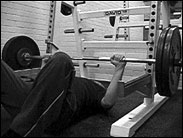 Yay! Following in the wake of a recent 105 kg/232 lbs decline bench PR, I managed the same on the floor press today. Moved on to 107.5 kg/238 lbs, but there was just a big BANG as I dropped it on the pins. Like on the declines, I made life simple and put 2.5 kg/5.5 lbs plates innermost to allow a smooth 10 kg/22 lbs pyramid all the way up to 105 kg/232 lbs. I don’t see much point in taxing the body with 100 kg/221 lbs if the goal is to do 105 kg/232 lbs. Better to just do 95 kg/210 lbs, then attempt 105 kg/232 lbs.
Yay! Following in the wake of a recent 105 kg/232 lbs decline bench PR, I managed the same on the floor press today. Moved on to 107.5 kg/238 lbs, but there was just a big BANG as I dropped it on the pins. Like on the declines, I made life simple and put 2.5 kg/5.5 lbs plates innermost to allow a smooth 10 kg/22 lbs pyramid all the way up to 105 kg/232 lbs. I don’t see much point in taxing the body with 100 kg/221 lbs if the goal is to do 105 kg/232 lbs. Better to just do 95 kg/210 lbs, then attempt 105 kg/232 lbs.
Satisfied. There is naturally footage on the aforementioned weekly video summary (6.5M).
8 @ 45 kg/99 lbs
6 @ 55 kg/122 lbs
2 @ 65 kg/144 lbs
1 @ 75 kg/166 lbs
1 @ 85 kg/188 lbs
1 @ 95 kg/210 lbs
1 @ 105 kg/232 lbs PR!
0 @ 107.5 kg/238 lbs
Cable front raise: 3x10 @ 30 kg/66 lbs
Close-grip pulldown with back against machine:
10 @ 50 kg/111 lbs
3x7 @ 70 kg/155 lbs
Seated cable L-flye: 2x12 @ 10 kg/22 lbs (?, didn’t record weight)
August 29, 2005
As concrete as it gets
The power rack project left behind a few sacks of concrete. Not wanting to waste that, figured I might just skip a few beats and ditch the wooden weight pit for a concrete one. After all, the few workouts I’ve done in it so far has convinced me this is one heck of an attraction.
I started work on this three weeks ago on the eve of leaving the summer cottage for the regular job in Helsinki. I did the frame one day until midnight, and then worked like a maniac the next day to get it all concreted before hopping on the southbound train with Rufus and Sanna. As we returned to celebrate the traditional Ostrobothnian end of the summer season on the last weekend of August, I got to uncover the now dry pit. Here’s the more than a thousand words thingy.
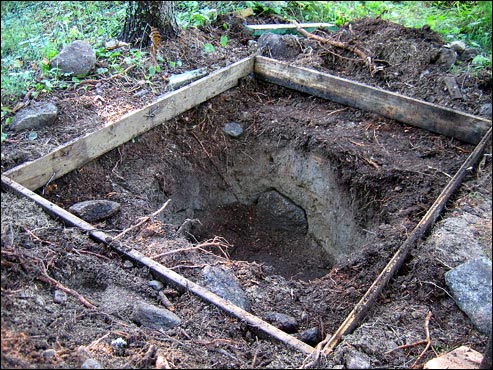
Step one: reluctantly tear down the “old” wooden top structure one has invested several hours in making, then put in an outer frame for the concrete and painstakingly make sure it is level in all directions.
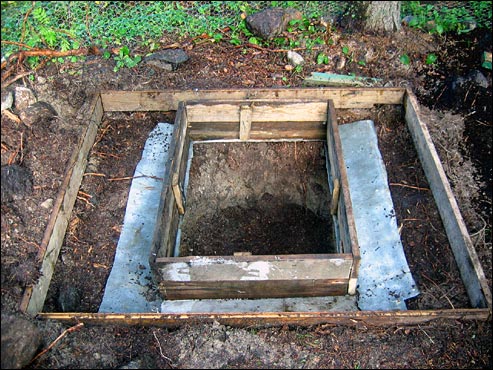
The inner frame in place. Notice the sheet metal that keeps the concrete from flowing down into the pit. The wood was ripped from old boards that once made up the weight shed at Toffe’s gym. The measurements correspond closely to that of the wooden pit, i.e. depth 60cm/23.4″, length 84 cm/32.8″, width 65 cm/25.4″.
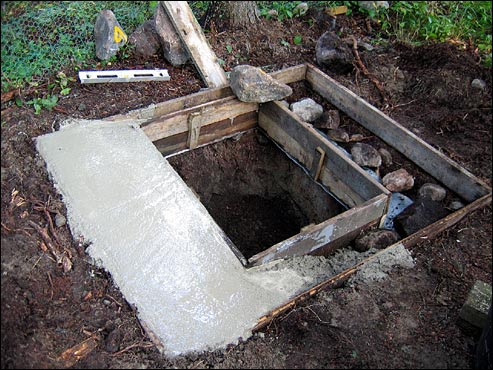
Partially filled frame. As usual, a few stones decorate the bottom in order to save some concrete.
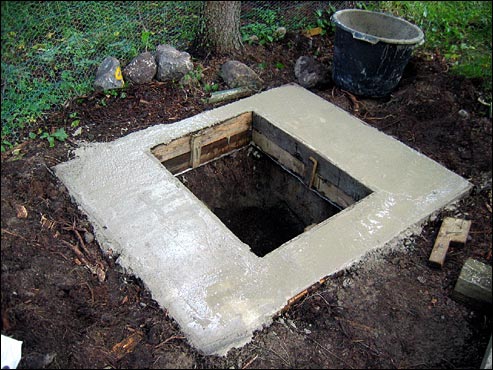
After sweating bucket loads whipping up several bags of concrete by hand, the frame was finally filled and the concrete carefully levelled out. Joy to the world!
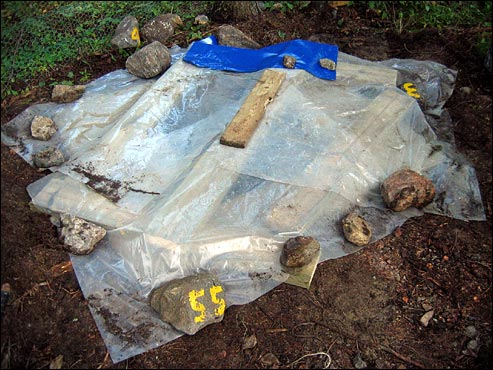
Ideally, concrete should be allowed to settle for a couple of days covered up to prevent moisture loss. The painted stones are fossiles from the flintstone’s era at Toffe’s when I used stones in buckets for resistance… This is how I left the pit before rushing off to the train via a quick dip in the sea (concrete in the ears does not make for a good public impression).
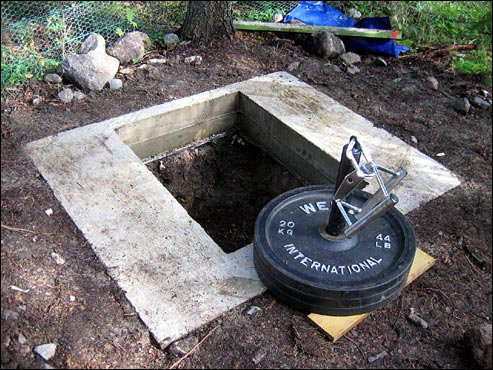
The uncovered pit upon the return a couple of weeks later. Guess who couldn’t wait to try it out… here the Ironmind loading pin is loaded to 60 kg/133 lbs for some light handle squats. Here’s the video (1.7M).
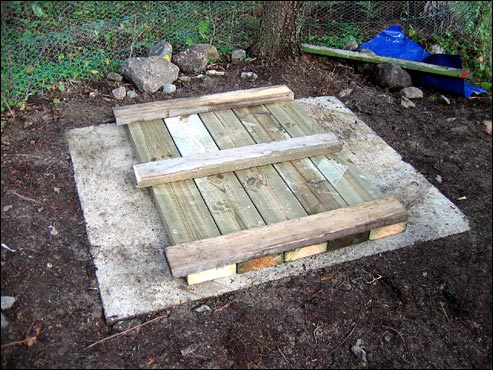
Holes in forests can be a deathtrap to both animals and humans alike as a poor mouse who fell into it can attest… not to mention how fun it is to step into a pit like this in the middle of the winter. For peace of mind, I nailed together a solid lid made of treated wood I bought for the purpose. I made sure to leave some gap between the boards to allow air to circulate (”hey, wanna try some handle deadlifts in my stinky pit?”). Mission complete.
August 31, 2005
Good traditions, bad traditions
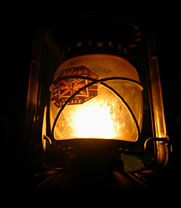 A veritable sea of light by the sea as lanterns, torches and bonfires light up the last dark weekend of August in the archipelago… the End of Summer festival is one great tradition indeed. Where there is great light, there must also be great darkness…evil traditions are arising out of its shadows. It doesn’t take Yoda to understand that I was out there looking to improve my 105 kg/232 lbs decline PR. I didn’t get it, instead I got what I got last year this very weekend… heavy duty back pain and a strong case of lumbago.
A veritable sea of light by the sea as lanterns, torches and bonfires light up the last dark weekend of August in the archipelago… the End of Summer festival is one great tradition indeed. Where there is great light, there must also be great darkness…evil traditions are arising out of its shadows. It doesn’t take Yoda to understand that I was out there looking to improve my 105 kg/232 lbs decline PR. I didn’t get it, instead I got what I got last year this very weekend… heavy duty back pain and a strong case of lumbago.
Not perhaps quite as bad as last year, but I had to forego all plans to clean up the debris in the gym following this year’s extensive renovation. As soon as I got back to Helsinki, I did the usual round. Actually, I didn’t even need to set foot in the occupational health clinic as a phone call was enough to get me the usual muscle relaxants and strong pain killers. At the back clinic, the doctor at first tried to ease up the cramp with the same means as a month ago, but he quickly abandoned the neural mobilization as even the starting position was severely painful. Instead, he jammed two pins into my low back to electrically force the cramping muscles to repeatedly contract in an effort to tire them. It is an experience in itself to feel the small muscles around the spine contract, I doubt they can be caused to fire in isolation without artificial means. After some fifteen or twenty minutes of contract-relax-contract-relax-contract-relax, I knew I would be sore in some funky places… The doctor told me I could expect the cramp to ease up over the next couple of days. He concluded that there was nothing structurally or neurologically wrong with my low back, something I should be thankful for. Knowing my scientific bent, he went on to sketch a picture of a vertebral disc from above explaining how the jelly-like center, the nucleus, is contained within a fibrous ring known as the annulus. Under normal circumstances, the disc returns to its original shape after absorbing pressure. But with age, the annulus is weakened and cracks can occur causing the acidic nucleus to spill out of its container thus coming into contact with the nerve roots. This in turn is what causes the lower back to cramp leading to the leaning tower of Pisa effect as the cramp causes the hip to shift to one side with a considerable drooping shoulder on the opposite side. This page over at a French back clinic explains this well with pictures, including the one below (the text is in English though).
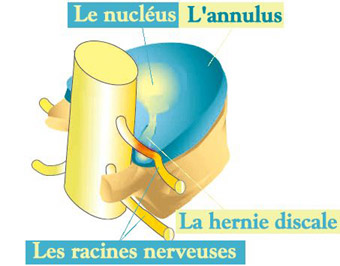
Almost into my second year of recurrent back trouble following the you-know-what, I received a clear diagnosis I can understand. This is so important I need to bold, hold on… What causes my back trouble is not a lingering back injury, but disc leakage due to abnormal levels of compression. Unfortunately, it appears that my “abnormal levels of compression” is abnormally low, say a 100 kg/221 lbs squat or 107.5 kg/238 lbs decline bench attempt. That said, it is not like this problem pops up out of the blue something. I have been able to sustain high levels of compression since the injury (for example, the Coan deadlift cycle in the spring), but for some reason a little is sometimes suddenly just too much. A stiff back, like I had before this workout, is a much more serious warning sign than I have ever understood. What this means to my powerlifting future, beyond the “stay away from the decline for now”, remains to be seen. Gargllleeeee.
Decline bench:
5 @ 40 kg/88 lbs
5 @ 50 kg/111 lbs
3 @ 60 kg/133 lbs
3 @ 70 kg/155 lbs
1 @ 80 kg/177 lbs
1 @ 90 kg/199 lbs
1 @ 100 kg/221 lbs
0 @ 107.5 kg/238 lbs
Behind-the-neck press:
8 @ 30 kg/66 lbs
5 @ 40 kg/88 lbs
3 @ 50 kg/111 lbs
3 @ 60 kg/133 lbs
0 @ 70 kg/155 lbs
0 @ 65 kg/144 lbs